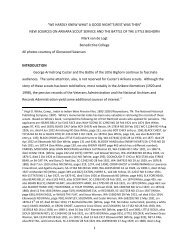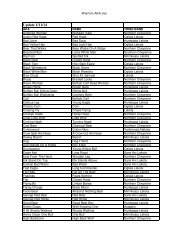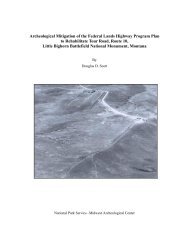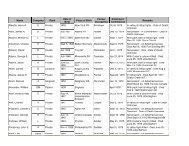Investigating the Oxbows and Testing Metal Detector Efficiency
Investigating the Oxbows and Testing Metal Detector Efficiency
Investigating the Oxbows and Testing Metal Detector Efficiency
You also want an ePaper? Increase the reach of your titles
YUMPU automatically turns print PDFs into web optimized ePapers that Google loves.
Figure 6. <strong>Metal</strong> detector team at work on <strong>the</strong> nor<strong>the</strong>rn most oxbow in tall grass.<br />
located include 3 cut nails, a tinned beer can, a fragment of clear glass associated with a wire<br />
nail, 2 wire nails, 2 nuts for bolts, an unidentified piece of strap iron, an unidentified iron<br />
collapsible frame, a 3-tine fork with wooden h<strong>and</strong>le, a 10 gauge shotshell base headstamped<br />
UMC/New Club, a 10 gauge shotshell base headstamped WRA, a .45-70-caliber cartridge<br />
headstamped WRA, an unidentified cast iron fragment, unidentified electrical splicing device, a<br />
tin can, <strong>and</strong> a copper harness rivet. The finds ranged in depth from surface to 25cm with most<br />
being found around 3-5cm below surface.<br />
The cut nails probably date after 1880 <strong>and</strong> <strong>the</strong> wire nail was not commonly in production until<br />
after 1890. The 3-tined fork is similar in style to ones found in late nineteenth century mail order<br />
catalogs. The shotshells <strong>and</strong> .45-70 cartridge were manufactured after 1929 <strong>and</strong> before 1978 as<br />
noted earlier. The material found in <strong>the</strong> grassy area appears to be a light scatter of late<br />
nineteenth <strong>and</strong> early twentieth century trash. The area may have once functioned as a disposal or<br />
discard area for <strong>the</strong> War Department administrators <strong>and</strong> later <strong>the</strong> National Park Service.<br />
The dense vegetation precluded all but <strong>the</strong> most r<strong>and</strong>om metal detector sweeps as <strong>the</strong> team could<br />
not swing <strong>the</strong> detectors nor reach <strong>the</strong> ground surface with <strong>the</strong> coils in most areas. The r<strong>and</strong>om<br />
detector sweeps of <strong>the</strong> heavily vegetated areas produced no metal targets with <strong>the</strong> VLF or PI<br />
machines.<br />
13








